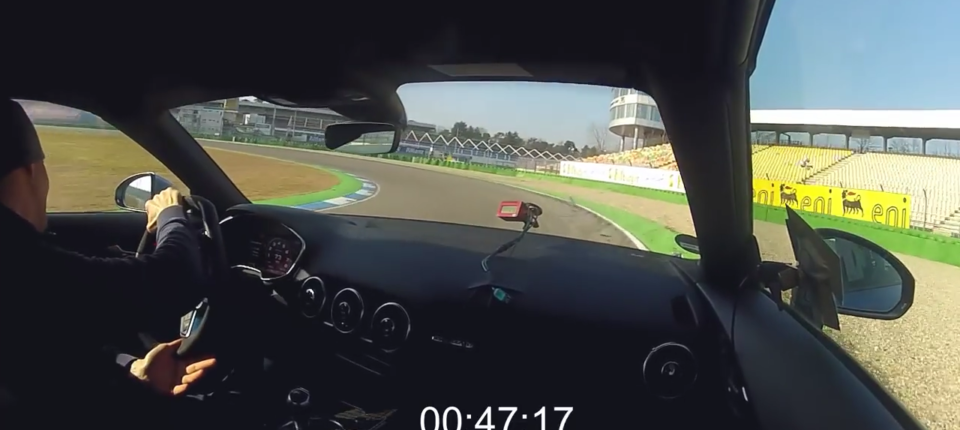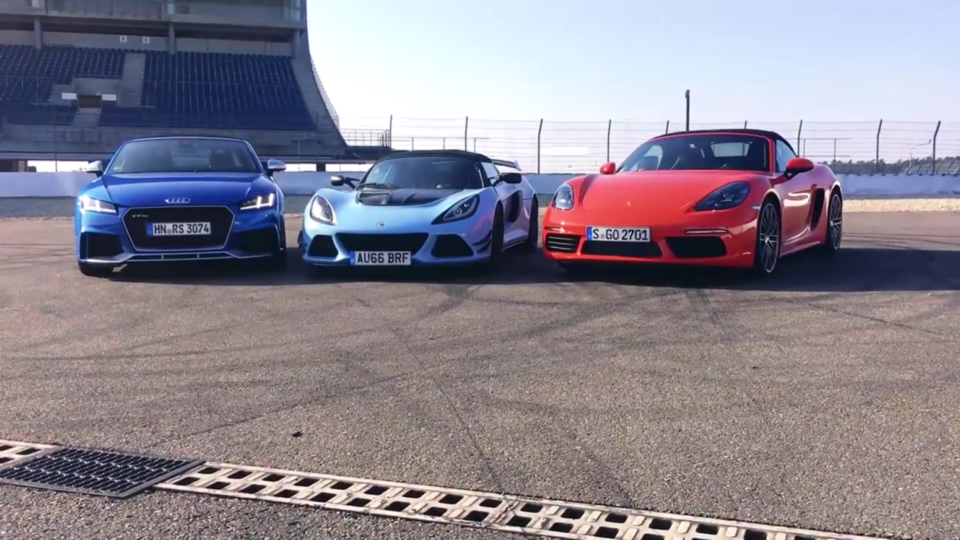Three different cars with different powerplants, purposes, and personalities. By far, the two German cars are the most usable, whereas the Lotus is not a friendly car for daily driving. Yet, with the most downforce, the least weight, and the edgiest setup, it ought to be the quickest of the bunch around Hockenheim.
The Exige Sport 380 has good high-speed stability and wonderful traction everywhere, and shows a neutral handling balance that edges towards mild understeer in the slower corners, though remains playful at higher speeds. The 310 pounds of downforce at its top speed of 178 miles an hour gives it some extra grip through the few high-speed corners at Hockenheim—but it still demands a delicate touch.
As the lightest and the least compromised car in the group, it seems to slide equally at both axles, and it wanders slightly during heavy braking—the wheel isn’t quite straight and it appears the rear starts to bobble slightly at 1:33. At the end of a committed lap marked by plenty of countersteering, it marks a 1:10.8. It looks like quite a challenge to wrangle, but the Exige Sport 380 seems to be a car that allows the experienced driver to push the envelope.
The Boxster S looks far more comfortable to drive. Perhaps what’s instantly recognizable about the car is the way its motor pulls relentlessly. Its 2.5-liter turbocharged boxer produces its peak torque figure (309 lb-ft) at 1,900 rpm, and the flat torque curve gives it the train-like pull to drag it out of any hairpin without fuss. That tractable four-cylinder makes it a very usable car, and the handling balance compliments the versatile powerplant.
Softer-edged and more composed over the bumps, Porsche’s mid-range sports car has the manners expected of a practical road car. In fact, it might be best-behaved car here. Only once does it break away, while riding the curbs at 3:17, but the car doesn’t snap, nor does it require any opposite lock; the car simply pivots at the rear axle as Christian Gebhardt straightens the wheel and keeps his right foot buried. In short, it’s more accommodating, but perhaps doesn’t provide the same level of precision that the Lotus does. As a result, it’s two tenths slower around the very technical Hockenheim—but that’s a great complement to the Boxster S.
The last car, the Audi, has a charm of all its own. Stylish, powerful, and versatile, it is perhaps the best real-world car. So much of its appeal lies with its barking five-cylinder, which produces a broad wave of torque in the same fashion as the Porsche, but with even more grunt: 400 horsepower and 354 lb-ft. Benefiting from four wheel-drive, the Audi is the quickest of the pack to sixty.
Despite the newest revisions made to the car—including shaving fifty-four pounds off the engine itself—the TT RS remains a car that’s reluctant to rotate. It looks reassuring, much like the Porsche, but lacks the incisiveness to excel on such a technical track. As the transmission sends power to the front axle most of the time, and only transfers a greater percentage to the rear when the system detects a difference in wheel speed between the two axles.

By squaring off the corner, he slows the entry, and turns briefly and forcefully to minimize the load on the front tires.
It’s evident from the amount of steering lock Gebhardt needs to use to get the car turned, but intelligently, he begins to alter his line somewhat to suit the push-prone Audi. Most notably in the corner called Sachs (4:35), he squares off the corner by turning in later and making a brief but forceful direction change to minimize the time spent turning, and to maximize the Audi’s best attribute: acceleration. Nonetheless, its balance issues hold it back, and make it the slowest of the group.




















